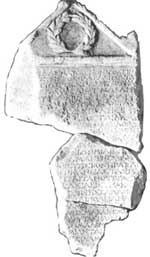
Decree honoring Diophantos
Inscription honoring the emperor Zeno
Civic Oath of Chersonesos
Decree honoring Syriskos the historian
Base of statue for Agasikles
Proxeny decree for an ambassador from Mithridates Eupator
Decree honoring ambassadors from Herakleia
Base of statue for Aristonos
Treaty of alliance with the king Pharnakes I
List of those who won sport competitions
Inscription about the tax on prostitution
Fragment of a decree about the fortress of Napites
Inscription about construction of a city gate
Dedication to the goddess Nemesis
Inscription regarding the liberation of Kalos Limen
Decree honoring the emperor Marcus Aurelius
Decree honoring Gaius Julius Satyrus
Proxeny for a citizen of Sinope
Epitaph in verse on stele for Xanthos
Inscription on the stele set up by doctor
Epitaph in verse on stele for Oinanthe
Short epitaphs
Originally published by Latyshev, commentary by Solomonik

|
Consists of three fragments of white marble slab. The top is decorated by pediment with image of laurel wreath. It is not known where and when was this inscription found. It was published in 1881, by V.N.Yurgevich, in the 12th volume of "Zapiski Odesskogo obshchestva istorii i drevnostey." The other fragments were found in 1908 in the north-eastern area of the ancient city. The monument dates to the second half of the 3d century B.C. |
Text:
"Herakleidas son of Parmenontos proposed: whereas Syriskos son of Herakleidas, having diligently described the appearances of Parthenos, read (the above), and about the relations towards the kings of Bosporos told, and the relations with the cities that were peaceful investigated according to the people's dignity, so in order to do him appropriate honors, be it resolved by the council and the people to praise him for that, and for the symmnamones to crown him with a golden wreath at the 21th day of Dionysia, and to make the (following) proclamation:
«The people crowns Syriskos son of Herakleidas for he described the appearances of Parthenos and the relations with the cities and the kings that were peaceful investigated truly and according to the state's dignity;" for the symmnamones to write this people's resolution on a stone slab and set up in the narthex of the temple of Parthenos; and for the treasurer of the sacred funds to provide the expense arising in these connections. These things were resolved by the council and the people, on the tenth day of the month (...)»"
Commentary:
This inscriptions mentions the most ancient historian Syriskos who described "the appearances of Parthenos", barbarians' attacks and other dangerous events from which Parthenos had saved her city, as well as the relations between Chersonesos and Bosporan kingdom and other states. For his historical works, which unfortunately did not preserve to these days, Syriskos was awarded with a golden wreath during festival of Dionysia. Similarly to Herodotus, he read his histories in public, probably in the theater, which existed in Chersonesos as early as the mid-3rd century B.C. Mentioned by the inscription symmnamones were the officials responsible for religious ceremonies and giving awards to the citizens.